生物英语教学大纲
高中生物教学大纲

高中生物教学大纲一、教学任务及对象1、教学任务本教学设计的任务是依据《高中生物教学大纲》进行课程的教学。
教学重点在于使学生掌握生物基础知识,理解生命现象和生物学原理,同时注重培养学生的科学探究能力和生物科学素养。
课程内容包括细胞结构与功能、生物多样性、生态系统的结构与功能、遗传与进化、生物技术等模块,旨在让学生在理论学习和实践操作中,形成对生物学科的系统认识和深度理解。
2、教学对象教学对象为高中阶段的学生,他们已经具备了一定的自然科学基础和逻辑思维能力,但对生物学的深入理解和复杂概念的学习可能还较为陌生。
因此,在教学过程中需要针对高中生的认知特点,采用适当的教学策略,激发学生的学习兴趣,引导学生主动探究,提高学生的生物学科素养。
此外,需考虑到学生个体差异,因材施教,确保每一位学生都能在生物学习中找到适合自己的学习路径。
二、教学目标1、知识与技能(1)掌握生物学的基本概念、原理和实验技能,如细胞的结构与功能、生物的分类与进化、生态系统的平衡与稳定、遗传的基本规律等。
(2)了解生物学研究的方法和过程,包括观察、实验、调查、数据分析等,能运用这些方法解决实际问题。
(3)运用所学的生物知识解释生活中的生物学现象,提高学生的科学素养和解决问题的能力。
(4)培养生物学的基本技能,如显微镜操作、生物绘图、实验设计等。
2、过程与方法(1)通过自主探究、小组合作、实验操作等方式,培养学生的科学思维和探究能力。
(2)运用比较、分析、综合、归纳等方法,提高学生分析和解决问题的能力。
(3)利用多媒体、网络资源等教学手段,丰富学生的学习途径,提高学生的学习兴趣和效果。
(4)注重过程评价,鼓励学生积极参与课堂讨论、展示、实验等活动,培养学生的学习自信。
3、情感,态度与价值观(1)激发学生对生物学科的兴趣,培养他们热爱自然、珍爱生命的情感。
(2)引导学生树立正确的生态观、环境观和资源观,增强社会责任感和使命感。
(3)培养学生严谨的科学态度,敢于质疑、勇于探索的精神。
普通生物学教学大纲(英文)

An Outline of General Biology Teaching Course Code: 0818531052Total Teaching Hour: 32Credit: 2Course Type: electiveMajor: BioengineeringPreparatory Courses: Inorganic Chemistry, Organic chemistry, BiochemistryTeaching aim and demand:General Biology is a basic course designed for students in majoring in the diverse fields of biological science such as forestry, animal science, biotechnology, and bioengineering. It included the basic knowledge and laws in biological science. To ensure that students have a broad exposure to and background in biology, we put great emphasis on fundamental principles and current research efforts and trends in biology. We attempt to introduce the milestones in life science and to bring the interest of life science research into university classroom by studying it, and then will provide the underlying basis for farther learning in this major.Methods in teachingThe course is mainly of classroom teaching supplied by multimedia teaching and some demonstrations. Some chapters except for some key parts will be taught by teachers or by students themselves. After class the students will be asked to finish homework needed. The bi-lingual teaching will be in progress step by step.Explanation:This outline is designed for students who are major in Biochemical Science and Technology. Due the students taking this course are expected to have taken preparatory courses as compulsory course, Inorganic Chemistry, organic chemistry, analysis chemistry, and Biology in senior high school .OutlineChapter 1 Introduction credit hours:2 Essential :The students should master the concept, characteristic and research method about life and know something about the biological science.Key point:The concept and characteristic of lifeDifficult points:The characteristic of lifeContent:Section 1 What Is LifeSection 2 Concepts and theories in life scienceSection 3 The methods of science researchSection 4 The branches of biologyChapter 2 Structure and Function of High Animal credit hours:14 Essential :The students should master some important the structure and function of high animal, such as digestion system, blood and circulation system, respiratory system , nervous system, immune system, excretory system and endocrine system, and should understand its adaptation and evolution to surviving environment in all kinds of animals.Key point:Animal tissue, organs and system. The structure and function of the digestive system, circulation system, respiratory system, nervous system and hormones regulation..Difficult points:Homeostasis and feedback; The structure and function of small intestine; The structure and function of heart and artery; The structure and function of brain; Hormones regulation.Content:Section 1 The tissue, organs and system in animalSection 2 Feeding, digestion, and nutrient absorptionSection 3 Respiration and gas exchangeSection 4 Blood and its circulationSection 5 Water balance and waste disposalSection 6 Nervous systems and nerve signal transductionSection 7 Animal hormones and transmission of chemical signals.Chapter 3 Structure and Function of Plant credit hours:8 Essential :The students should master some important structure and function of plant, and should capture some important physiology mechanism such as transpiration, internal transport, regulation in plant.Key point:Plant cells and tissues; Plant vegetative organs and their growth; Transport and absorption of water, mineral, organic compounds; Floral structure; Plant hormones and their effects on growth and development.Difficult points:Plant cells and tissues; Transport and absorption of water, mineral, organic compounds; Plant hormones and their effects on growth and development.;Content:Section 1 Structure, Reproduction and GrowthSection 2 Plant Nutrition and Internal TransportSection 3 Regulations System of PlantChapter 4 Heredity and Variation credit hours:4 Essential :The students should master the basic laws of inheritance and the chromosome theory of inheritance, and should know some important theory about gene.Key point:The basic laws of inheritance. The chromosome theory of inheritance. The essence of gene. Genetic linkage and crossing over.Difficult points:The basic laws of inheritance. The chromosome theory of inheritance. Genetic linkage and crossing over.Content:Section 1The law of MendelSection 2 The chromosome theory of inheritance.Section 3 Genetic linkage and crossing overChapter 5 The Evolution of Life credit hours:4A species come to being, and should master the evolution of biodiversity in prokaryotes, plant, animal and human being.Key point:The theory of evolution by natural selection. The law of Hardy and Weinberg. The evolution of biodiversity in animal.Difficult points:The law of Hardy and Weinberg. The evolution of biodiversity in animal.Content:Section 1Darwin and the theory of evolution by natural selectionSection 2 Gene frequency and natural selectionSection 3 Species formation, adaptation and evolution.Section 4 The evolution of biodiversityTable of teaching content and hour distribution :Demand for Self-Studies: Due to its big contents and difficulties, the course requiresthe student more self-studies as well as classroom learning.Measure and Scores: The course needs a close-papered test with a portion of final-exam and daily contributes: 30% daily+70%final exam.Textbooks Recommended:Xiangyu Wu ,General Biology2nd, High education press,2005Jianping Xu, Qingyu Wu, Essentials of Life Science, High education press,2006Reference:1.Yuezeng Chen, General Biology1st, High education press ,1999.2. Neil.Camplell, Jane B. Reece, Eric J. Simon, Essential Biology, High education press2002.3. ZhiXing Gu, Guiquan Zhang, General Biology, High education press 2007.Supervisor:(Signature)Li Jiayou Editor in Chief:(Signature)Wang yujie Participants:Teachers of bioengineering department。
《生物工程专业英语》课程教学大纲
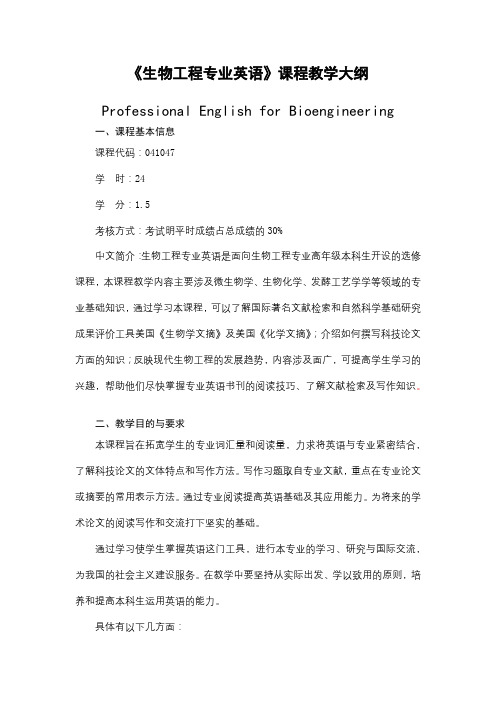
《生物工程专业英语》课程教学大纲Professional English for Bioengineering一、课程基本信息课程代码:041047学时:24学分:1.5考核方式:考试明平时成绩占总成绩的30%中文简介:生物工程专业英语是面向生物工程专业高年级本科生开设的选修课程,本课程教学内容主要涉及微生物学、生物化学、发酵工艺学学等领域的专业基础知识,通过学习本课程,可以了解国际著名文献检索和自然科学基础研究成果评价工具美国《生物学文摘》及美国《化学文摘》;介绍如何撰写科技论文方面的知识;反映现代生物工程的发展趋势,内容涉及面广,可提高学生学习的兴趣,帮助他们尽快掌握专业英语书刊的阅读技巧、了解文献检索及写作知识。
二、教学目的与要求本课程旨在拓宽学生的专业词汇量和阅读量,力求将英语与专业紧密结合,了解科技论文的文体特点和写作方法。
写作习题取自专业文献,重点在专业论文或摘要的常用表示方法。
通过专业阅读提高英语基础及其应用能力。
为将来的学术论文的阅读写作和交流打下坚实的基础。
通过学习使学生掌握英语这门工具,进行本专业的学习、研究与国际交流,为我国的社会主义建设服务。
在教学中要坚持从实际出发、学以致用的原则,培养和提高本科生运用英语的能力。
具体有以下几方面:1.掌握本学科所需的常用专业词及词组。
2.能比较顺利地阅读本专业的英文资料,理解正确。
3.能借助词典将本专业的资料进行汉英互译,要求理解正确,译文通顺;正确表达思想,无重大语言错误。
4.能用英文书写论文摘要,正确表达原意。
三、教学方法与手段教学内容及目标1教学方法:讲授法,兼有提问、平时测验和查阅专业文献并讨论。
2教学手段:采用多媒体、板书。
为了实现教学目标,本课程有两位教师共同完成,并为学生指定课外阅读资料和相关参考书,每篇文章后会及时测验。
同时,让学生查阅与专业相关的英文的文献,阅读和理解专业文献后,进行分组讨论式教学,学生以小组为单位进行讨论,通过大量阅读文献,提高学生的专业词汇量和对专业文献的理解能力。
高中生物的教学大纲(最新)

高中生物的教学大纲(最新)高中生物教学大纲高中生物教学大纲应由教育部生物教育司负责制定,主要内容包括:1.高中生物课程的任务:是使学生获得生物学的基础知识,了解并关注这些知识在生活、生产和社会发展中的应用;帮助学生形成对自然和社会的正确态度,学习生物科学的研究方法,发展智力和能力,培养学生创新精神,科学地探究未知,提高学生科学素养,形成科学的价值观。
2.课程理念:提高生物科学素养,面向全体学生,倡导探究性学习,注重与生活、生产实际的联系。
3.知识领域:包括分子与细胞水平、个体水平、群体与生态系统水平、生物技术应用、生物科学与社会发展、生物科学与社会进步、生物科学与伦理道德等。
4.课程结构:必修模块+选修模块。
必修模块是全体高中学生必须学习的内容,包括分子与细胞、遗传与进化、稳态与环境。
选修模块是供学生选择的学习内容,包括生物技术实践、生物科学与社会和现代生物科技专题。
5.必修模块:包括分子与细胞、遗传与进化、稳态与环境三个模块。
6.选修模块:包括生物技术实践、生物科学与社会和现代生物科技专题三个模块。
7.教学内容的确定与评价:教学内容的确定与评价应根据实际情况灵活进行。
8.课程资源的开发与利用:积极开发并利用校内外各种课程资源,包括学生的家庭条件、生活经历和当地实际等。
9.教学质量的监控:要建立高中生物学业水平测试和学分认定制度,并逐步完善监控体系。
10.教材编写建议:教材内容的选择应坚持基础性,必须注重科学性,具有时代性,有利于促进学生的发展。
11.评价建议:评价应有利于学生了解有关生物科学知识在生活和社会发展中的应用;有利于增强学生学习生物学的兴趣,进一步转变学习方式;有利于教师专业发展和提高教学水平。
12.命题建议:命题应有利于全面考查学生掌握双基、情感态度与价值观的情况;有利于减轻学生过重的课业负担;有利于高中新课程实施和高中生物教学质量的全面提高。
以上就是高中生物教学大纲的大致内容,希望对您有所帮助。
蒋悟生《生物专业英语》教学案

蒋悟生《生物专业英语》教/学案Lesson One(4学时)Inside the Living Cell: Structure and Function of Internal Cell PartsLesson One(4学时)Inside the Living Cell: Structure and Function of Internal Cell Parts教学目的:使学生掌握细胞的组成结构(各种细胞器以及它们在细胞中的位置),以及结构与功能之间的关系。
各细胞器及功能相关英语词汇以及主要用法。
教学重点:各细胞器的概念和功能,及相关英语词汇的掌握教学难点:专业英语词汇的记忆讲授方法:以学生翻译为主,老师讲解相关专业知识辅助学生理解授课时间:3月22日;3月29日教学内容:Cytoplasm: The Dynamic, Mobile Factory细胞质:动力工厂Most of the properties we associate with life are properties of the cytoplasm. Much of the mass of a cell consists of this semifluid substance, which is bounded on the outside by the plasma membrane. Organelles are suspended within it, supported by the filamentous network of the cytoskeleton. Dissolved in the cytoplasmic fluid are nutrients, ions, soluble proteins, and other materials needed for cell functioning.生命的大部分特征表现在细胞质的特征上。
生物化学(双语)课程教学大纲

《生物化学(双语)》课程教学大纲课程编号:2130053学时:48学分:3.0授课学院:药物科学与技术学院适用专业:药学教材:Lehninger Principles of Biochemistry, Fourth Edition (2005).作者: David L. Nelson and Michael M. Cox 出版社:W. H. Freeman一.课程的性质、目的及任务生物化学是一门利用化学的理论和方法作为主要手段来研究生命现象,揭示生命的奥秘的学科。
其主要任务有两个方面:一方面研究构成生物体的基本物质:蛋白质、核酸、糖、脂及对体内的生物化学反应起催化和调节作用的酶、维生素、激素的结构性质和功能,即所谓静态生物化学,另一方面研究构成生物体的基本物质在生命活动过程中进行的化学变化,即新陈代谢过程中的物质和能量转换和调节,即动态生物化学部分。
二.教学基本要求(一)基础理论和基本知识1、蛋白质的结构和功能掌握蛋白质的化学组成、理化性质、分子结构及其与功能的关系,熟悉蛋白质的提取和纯化方法。
2、酶掌握酶的基本概念及影响酶活性的因素,酶结构与功能的关系。
掌握酶反应速率的相关理论。
3、糖化学及其代谢掌握糖的分类及结构,糖酵解、三羧酸循环途径。
熟悉糖原的合成代谢及分解代谢。
4、脂类化学及其代谢掌握脂类的组成及结构,熟悉脂肪的合成代谢及磷脂的合成。
5、核酸化学掌握核苷酸的结构,核酸的结构与功能,熟悉核酸分离纯化的机理。
了解核酸的医药用途。
6、基因信息的贮存和表达掌握DNA、RNA 的分子结构和功能、中心法则、DNA的半保留复制。
熟悉DNA 损伤修复,RNA和蛋白质生物合成、核酸的分子杂交、基因工程及聚合酶链反应。
(二)、基本技能掌握DNA提取及琼脂糖、聚丙烯酰胺凝胶电泳技术,熟悉紫外-可见分光光度计的用法,了解利用HPLC分离鉴定蛋白质的方法。
三.教学内容糖、脂、蛋白质、酶、核酸化学及基因信息的储存和表达。
生物化学(英文版)教学大纲
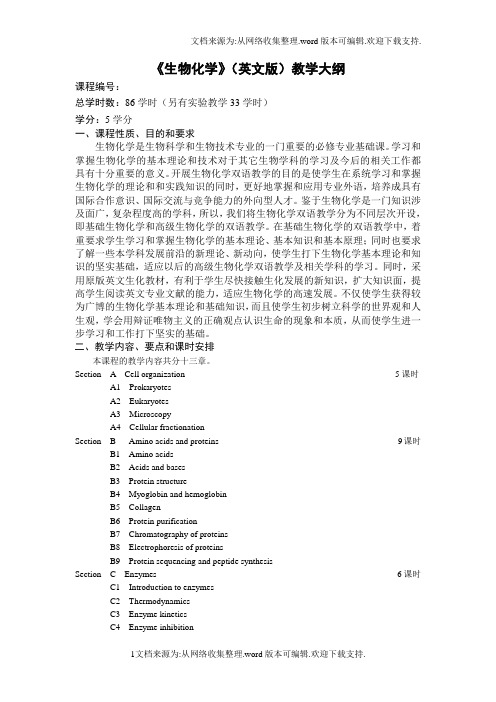
《生物化学》(英文版)教学大纲课程编号:总学时数:86学时(另有实验教学33学时)学分:5学分一、课程性质、目的和要求生物化学是生物科学和生物技术专业的一门重要的必修专业基础课。
学习和掌握生物化学的基本理论和技术对于其它生物学科的学习及今后的相关工作都具有十分重要的意义。
开展生物化学双语教学的目的是使学生在系统学习和掌握生物化学的理论和和实践知识的同时,更好地掌握和应用专业外语,培养成具有国际合作意识、国际交流与竞争能力的外向型人才。
鉴于生物化学是一门知识涉及面广,复杂程度高的学科,所以,我们将生物化学双语教学分为不同层次开设,即基础生物化学和高级生物化学的双语教学。
在基础生物化学的双语教学中,着重要求学生学习和掌握生物化学的基本理论、基本知识和基本原理;同时也要求了解一些本学科发展前沿的新理论、新动向,使学生打下生物化学基本理论和知识的坚实基础,适应以后的高级生物化学双语教学及相关学科的学习。
同时,采用原版英文生化教材,有利于学生尽快接触生化发展的新知识,扩大知识面,提高学生阅读英文专业文献的能力,适应生物化学的高速发展。
不仅使学生获得较为广博的生物化学基本理论和基础知识,而且使学生初步树立科学的世界观和人生观,学会用辩证唯物主义的正确观点认识生命的现象和本质,从而使学生进一步学习和工作打下坚实的基础。
二、教学内容、要点和课时安排本课程的教学内容共分十三章。
Section A Cell organization 5课时A1 ProkaryotesA2 EukaryotesA3 MicroscopyA4 Cellular fractionationSection B Amino acids and proteins 9课时B1 Amino acidsB2 Acids and basesB3 Protein structureB4 Myoglobin and hemoglobinB5 CollagenB6 Protein purificationB7 Chromatography of proteinsB8 Electrophoresis of proteinsB9 Protein sequencing and peptide synthesisSection C Enzymes 6课时C1 Introduction to enzymesC2 ThermodynamicsC3 Enzyme kineticsC4 Enzyme inhibitionC5 Regulation of enzyme activitySection D Antibodies 6课时D1 The immune systemD2 Antibody structureD3 Polyclonal and monoclonal antibodiesD4 Antibody synthesisD5 Antibodies as toolsSection E Membranes 6课时E1 Membrane lipidsE2 Membrane protein and carbohydrateE3 Membrane transport: small moleculesE4 Membrane transport: macromoleculesE5 Signal transudationSection F DNA structure and replication 6课时F1 DNA structureF2 ChromosomesF3 DNA replication in bacteriaF4 DNA replication in eukaryotesSection G RNA synthesis and processing 8课时G1 RNA structureG2 Transcription in prokaryotesG3 The lac operonG4 The trp operonG5 Transcription in eukaryotes: an overviewG6 Transcription of protein-coding genes in eukaryotesG7 Regulation of transcription by RNA Pol ⅡG8 Processing of eukaryotic Pre-mRNAG9 Ribosomal RNAG10 Transfer RNASection H Protein synthesis 6课时H1 The genetic codeH2 Translation in prokaryotesH3 Translation in eukaryotesH4 Protein targetingH5 Protein glycosylationSection I Recombinant DNA technology 6课时I1 Restriction enzymesI2 Nucleic acid hybridizationI3 DNA cloningI4 VirusesI5 DNA sequencingI6 Polymerase chain reactionSection J Carbohydrate metabolism 10课时J1 Monosaccharides and disaccharidesJ2 Polysaccharides and oligosaccharidesJ3 GlycolysisJ4 GluconeogenesisJ5 Pentose Phosphate PathwayJ6 Glycogen MetabolismJ7 Control of glycogen metabolismSection K Lipid metabolism 6课时K1 Structures and roles of fatty acidsK2 Fatty acid breakdownK3 Fatty acid synthesisK4 TriacylglycerolsK5 CholesterolK6 LipoproteinsSection L Respiration and energy 6课时L1 Citric acid cycleL2 Electron transport and oxidative phosphorylationL3 PhotosynthesisSection M Nitrogen metabolism 6课时M1 Nitrogen fixation and assimilationM2 Amino acid metabolismM3 The urea cycleM4 Hemes and chlorophylls三、教学方法采用英文原版教材,实行双语教学,制作PPT课件,利用多媒体技术和适当的板书辅助教学。
生物化学双语课程教学大纲

*学习目标(Learning Outcomes)
1.结构生物化学
主要培养学生的基础知识、研究能力、科学素养。
1)生物化学是一门发展中的学科:生物化学是生物多样性的基础;DNA阐明了组成和功能之间的相互关系;从化学概念解释生物分子的性质;基因组学和蛋白组学最新进展;认识到生物化学是生命科学必备的基础知识。
2.MetabolismBiochemistry
Focus on basic knowledge, scientific literacy, andresearch ability.
7)Metabolism: Basic Concepts and Design:Basic ConceptsofMetabolism; ATP;The Oxidation of Carbon Fuels Is an important Source of Cellular Energy; Metabolic Pathways Contain Many Recurring Motifs.
5)糖与糖蛋白:单糖;复杂糖(寡糖和多糖);糖蛋白;凝集素。
6)脂与生物膜:脂肪酸;三类膜脂质分子(磷脂、糖脂、和胆固醇);脂质双分子层;膜蛋白。
2.代谢生物化学
主要培养学生的基础知识、研究能力、科学素养。
7)代谢总论:代谢的基本概念;ATP;碳氧化供能;代谢过程反复使用的模式。
8)氧化磷酸化:电子传递链;氧化磷酸化及调控机制;线粒体内膜的穿梭系统。
Course Introduction:
This courseincludes23chapters.Itcovers twosections: structure biochemistry and metabolism biochemistry.
生物专业英语教学大纲
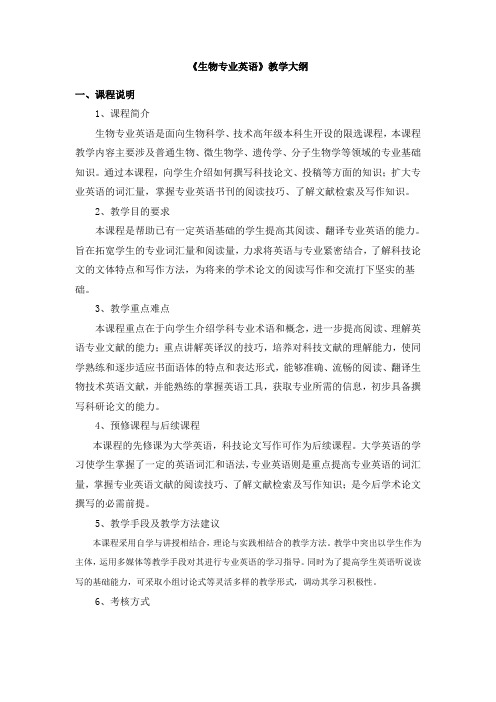
《生物专业英语》教学大纲一、课程说明1、课程简介生物专业英语是面向生物科学、技术高年级本科生开设的限选课程,本课程教学内容主要涉及普通生物、微生物学、遗传学、分子生物学等领域的专业基础知识。
通过本课程,向学生介绍如何撰写科技论文、投稿等方面的知识;扩大专业英语的词汇量,掌握专业英语书刊的阅读技巧、了解文献检索及写作知识。
2、教学目的要求本课程是帮助已有一定英语基础的学生提高其阅读、翻译专业英语的能力。
旨在拓宽学生的专业词汇量和阅读量,力求将英语与专业紧密结合,了解科技论文的文体特点和写作方法,为将来的学术论文的阅读写作和交流打下坚实的基础。
3、教学重点难点本课程重点在于向学生介绍学科专业术语和概念,进一步提高阅读、理解英语专业文献的能力;重点讲解英译汉的技巧,培养对科技文献的理解能力,使同学熟练和逐步适应书面语体的特点和表达形式,能够准确、流畅的阅读、翻译生物技术英语文献,并能熟练的掌握英语工具,获取专业所需的信息,初步具备撰写科研论文的能力。
4、预修课程与后续课程本课程的先修课为大学英语,科技论文写作可作为后续课程。
大学英语的学习使学生掌握了一定的英语词汇和语法,专业英语则是重点提高专业英语的词汇量,掌握专业英语文献的阅读技巧、了解文献检索及写作知识;是今后学术论文撰写的必需前提。
5、教学手段及教学方法建议本课程采用自学与讲授相结合,理论与实践相结合的教学方法。
教学中突出以学生作为主体,运用多媒体等教学手段对其进行专业英语的学习指导。
同时为了提高学生英语听说读写的基础能力,可采取小组讨论式等灵活多样的教学形式,调动其学习积极性。
6、考核方式本课程为考查课,期末开卷考试。
总成绩满分一百分,包括平时成绩占20%+期末考试成绩80%。
7、指定教材蒋悟生主编,生物专业英语(第二版),高等教育出版社,2000年。
8、教学参考书[1] 邬行彦等编,生物工程、生物技术专业英语(第一版),化学工业出版社,2002年。
生物英语教学大纲
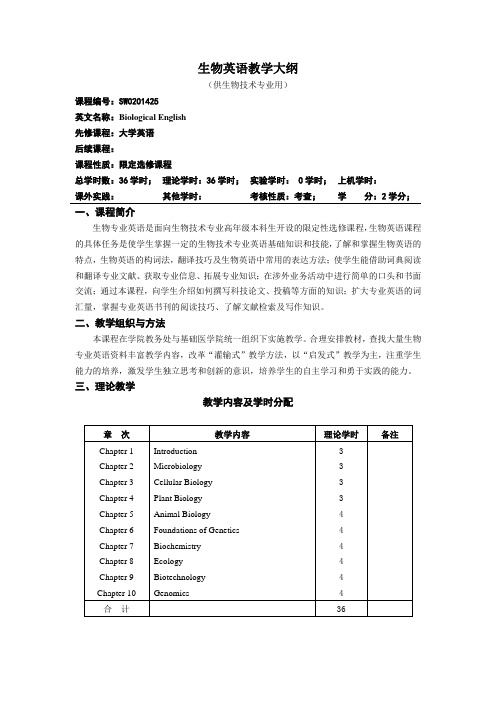
生物英语教学大纲(供生物技术专业用)课程编号:SW0201425英文名称:Biological English先修课程:大学英语后续课程:课程性质:限定选修课程总学时数:36学时;理论学时:36学时;实验学时: 0学时;上机学时:课外实践:其他学时:考核性质:考查;学分:2学分;一、课程简介生物专业英语是面向生物技术专业高年级本科生开设的限定性选修课程,生物英语课程的具体任务是使学生掌握一定的生物技术专业英语基础知识和技能,了解和掌握生物英语的特点,生物英语的构词法,翻译技巧及生物英语中常用的表达方法;使学生能借助词典阅读和翻译专业文献、获取专业信息、拓展专业知识;在涉外业务活动中进行简单的口头和书面交流;通过本课程,向学生介绍如何撰写科技论文、投稿等方面的知识;扩大专业英语的词汇量,掌握专业英语书刊的阅读技巧、了解文献检索及写作知识。
二、教学组织与方法本课程在学院教务处与基础医学院统一组织下实施教学。
合理安排教材,查找大量生物专业英语资料丰富教学内容,改革“灌输式”教学方法,以“启发式”教学为主,注重学生能力的培养,激发学生独立思考和创新的意识,培养学生的自主学习和勇于实践的能力。
三、理论教学教学内容及学时分配Chapter 1 Introduction【目的要求】1.了解:Characteristics of professional English2.熟悉:Notion of English for biology3.掌握:I nternet resources of professional English【教学内容】1.Definition of biology2.Origin of life3.Significance of biology4.History of biology【计划学时】3学时Chapter 2 Microbiology【目的要求】1.了解:Professional words and phrases2.熟悉:Modern microbiology3.掌握:Translation from Chinese to English【教学内容】1.Short introduction of microbiology2.Introduction to prokaryotes, eukaryotic microbes and viruses3.Future of microbiology4.Relevance of microbiology【计划学时】3学时Chapter 3 Cellular Biology【目的要求】1.了解:Some difficult sentences2.熟悉:Professional words and phrases3.掌握:Introduction of cells【教学内容】1.Introduction to cells2.Scope of cells3.Concepts in Mammalian cell culture【计划学时】3学时Chapter 4 Plant Biology【目的要求】1.了解:Definition of protista and biochemical2.熟悉:Professional words and phrases3.掌握:Main idea of the passage【教学内容】1.Introduction to Botany2.Flowers, fruits and seeds of plants3.Definition of photosynthesis4.Achievements of transgenic plants【计划学时】3学时Chapter 5 Animal Biology 【目的要求】1.了解:Meaning of the passage2.熟悉:Difficult sentences of the passage3.掌握:Translation from Chinese to English【教学内容】1.Concept of zoology2.Introduction to animals’ organ systems3.Study of transgenic animals【计划学时】4学时Chapter 6 Foundations of Genetics 【目的要求】1.了解:Some difficult sentences2.熟悉:Professional words and phrases3.掌握:Main idea of the passage【教学内容】1.Introduction to gene2.Hunctional structure of a gene3.Gene expression and essentials for genetic engineering 【计划学时】4学时Chapter 7 Biochemistry【目的要求】1.了解:Basic terminologies of the passage2.熟悉:Translation from English to Chinese3.掌握:Difficult sentences of the passage【教学内容】1.Introduction to enzymes2.Metabolism3.Metabolic pathway【计划学时】4学时Chapter 8 Ecology【目的要求】1.了解:Professional words and phrases2.熟悉:Comprehension of the passage3.掌握:Translation from Chinese to English【教学内容】1.Concept of ecology2.Introduction to ecosystems3.Biodiversity【计划学时】4学时Chapter 9 Biotechnology【目的要求】1.了解:Some difficult sentences2.熟悉:Professional words and phrases3.掌握:Introduction to DNA technology【教学内容】1.Study of bioprocess2.Scope of bioengineering3.Recombinant DNA technology【计划学时】4学时Chapter 10 Genomics【目的要求】1.了解:Professional words of genomics2.熟悉:Relevant information of genomics3.掌握:Main idea of the passage【教学内容】1.DNA sequencing2.Coding region3.Functional genomics【计划学时】4学时四、课程考核性质、形式及成绩评定本课程性质为考查课;考核形式为闭卷;考核成绩由期末成绩和平时成绩两部分组成,其中期末成绩占考核成绩70%,平时成绩(含平时测试、作业测评、出勤情况、课堂表现)占考核成绩30%,考核成绩60分(含60分)以上者为合格。
2023年新版义务教育生物教学大纲英文版
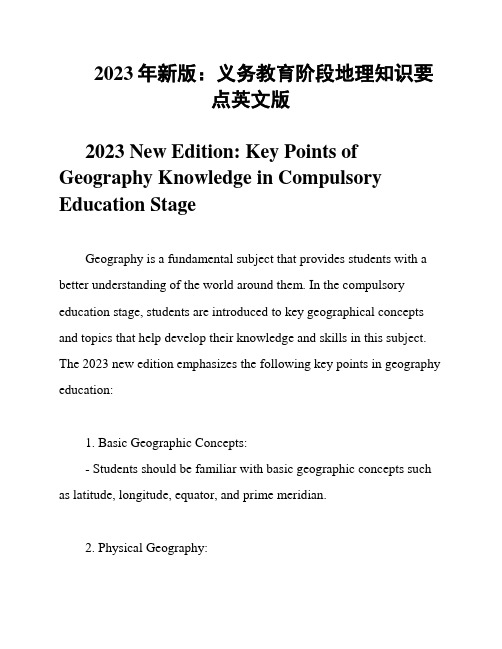
2023年新版:义务教育阶段地理知识要点英文版2023 New Edition: Key Points of Geography Knowledge in Compulsory Education StageGeography is a fundamental subject that provides students with a better understanding of the world around them. In the compulsory education stage, students are introduced to key geographical concepts and topics that help develop their knowledge and skills in this subject. The 2023 new edition emphasizes the following key points in geography education:1. Basic Geographic Concepts:- Students should be familiar with basic geographic concepts such as latitude, longitude, equator, and prime meridian.2. Physical Geography:- Understanding the physical features of the Earth, including mountains, rivers, oceans, and deserts, is essential in geography education.3. Climate and Weather:- Students should learn about different climate zones, weather patterns, and natural disasters to gain a comprehensive understanding of the Earth's climate.4. Human Geography:- Exploring human activities such as population distribution, urbanization, and cultural diversity helps students understand the impact of humans on the environment.5. Environmental Issues:- Educating students about environmental issues like pollution, deforestation, and climate change is crucial in promoting environmental awareness and sustainability.6. Map Reading Skills:- Developing map reading skills, including interpreting topographic maps, political maps, and thematic maps, is an important aspect of geography education.7. Geographic Information Systems (GIS):- Introducing students to GIS technology and its applications in analyzing geographic data enhances their spatial thinking and problem-solving skills.8. Globalization:- Understanding the concept of globalization and its effects on economies, cultures, and the environment is essential in a modern geography curriculum.9. Sustainable Development:- Promoting awareness of sustainable development goals and strategies helps students recognize the importance of preserving natural resources for future generations.10. Case Studies:- Studying real-world examples and case studies of geographic phenomena and events provides students with practical insights into the application of geographic knowledge.By focusing on these key points in geography education, the 2023 new edition aims to equip students with a solid foundation in geographic knowledge and skills that are relevant and applicable in today's interconnected world.。
高中生物教学大纲[1]1
![高中生物教学大纲[1]1](https://img.taocdn.com/s3/m/a044ef27ae1ffc4ffe4733687e21af45b307fe98.png)
高中生物教学大纲一、引言生物学是研究生物体的组成、结构、功能、分类、演化和相互关系的科学。
高中生物教学大纲是根据国家教育教学要求和学校教学实际制定的,旨在培养学生对生命科学的基本知识和基本方法的认识和理解,发展学生的观察、实验、分析和解决问题的能力,以及培养学生的创新精神和科学素养。
高中生物教学的主要目标是培养学生的科学素养、创新精神和生命科学的基本知识和基本方法。
具体目标包括: 1. 掌握生物的基本概念、基本原理和基本观点; 2. 理解生物与环境的关系,了解生物的多样性和适应性; 3. 掌握生物学实验的基本方法和基本技能;4. 发展对生物学问题的观察、实验、分析和解决问题的能力; 5. 培养对生命科学的兴趣和探索精神。
1.生物的基本概念和基本原理–细胞理论–遗传学原理–进化理论2.生物的结构与功能–细胞结构和功能–器官系统结构和功能–生物分子结构和功能3.生物的分类与演化–生物分类的原则和方法–生物演化的基本概念和证据4.生物与环境的关系–生物对环境的适应与变异–生物对环境的影响与调节5.生物的多样性与适应性–植物的多样性与适应性–动物的多样性与适应性6.生物学实验–实验设计和实验操作技能–实验数据的处理和分析方法–实验结果的评价和结论的推断四、教学方法1.讲授法:通过教师的讲解、示范和演示,向学生传授生物学的基本概念、基本原理和基本知识。
2.实验法:组织学生进行生物学实验,让学生亲自动手操作、观察和记录实验数据,培养学生的实验设计和实验操作技能。
3.讨论法:组织学生进行小组讨论、课堂讨论和专题讨论,让学生通过交流和讨论,加深对生物学的理解和应用。
4.案例分析法:通过实例和案例的引入,让学生分析和解决真实生活中的生物学问题,培养学生的问题解决能力和创新思维。
五、教学评价与考核1.学生日常表现:包括课堂参与、实验操作、课后作业等方面的评价。
2.期中考试:对教学内容进行综合考核,考察学生对生物学的基本概念、基本原理和基本知识的掌握程度。
- 1、下载文档前请自行甄别文档内容的完整性,平台不提供额外的编辑、内容补充、找答案等附加服务。
- 2、"仅部分预览"的文档,不可在线预览部分如存在完整性等问题,可反馈申请退款(可完整预览的文档不适用该条件!)。
- 3、如文档侵犯您的权益,请联系客服反馈,我们会尽快为您处理(人工客服工作时间:9:00-18:30)。
生物英语教学大纲
(供生物技术专业用)
课程编号:SW0201425
英文名称:Biological English
先修课程:大学英语
后续课程:
课程性质:限定选修课程
总学时数:36学时;理论学时:36学时;实验学时: 0学时;上机学时:
课外实践:其他学时:考核性质:考查;学分:2学分;
一、课程简介
生物专业英语是面向生物技术专业高年级本科生开设的限定性选修课程,生物英语课程的具体任务是使学生掌握一定的生物技术专业英语基础知识和技能,了解和掌握生物英语的特点,生物英语的构词法,翻译技巧及生物英语中常用的表达方法;使学生能借助词典阅读和翻译专业文献、获取专业信息、拓展专业知识;在涉外业务活动中进行简单的口头和书面交流;通过本课程,向学生介绍如何撰写科技论文、投稿等方面的知识;扩大专业英语的词汇量,掌握专业英语书刊的阅读技巧、了解文献检索及写作知识。
二、教学组织与方法
本课程在学院教务处与基础医学院统一组织下实施教学。
合理安排教材,查找大量生物专业英语资料丰富教学内容,改革“灌输式”教学方法,以“启发式”教学为主,注重学生能力的培养,激发学生独立思考和创新的意识,培养学生的自主学习和勇于实践的能力。
三、理论教学
Chapter 1 Introduction
【目的要求】
1.了解:Characteristics of professional English
2.熟悉:Notion of English for biology
3.掌握:I nternet resources of professional English 【教学内容】
of biology
of life
of biology
of biology
【计划学时】3学时
Chapter 2 Microbiology 【目的要求】
1.了解:Professional words and phrases
2.熟悉:Modern microbiology
3.掌握:Translation from Chinese to English
【教学内容】
introduction of microbiology
to prokaryotes, eukaryotic microbes and viruses
of microbiology
of microbiology
【计划学时】3学时
Chapter 3 Cellular Biology 【目的要求】
1.了解:Some difficult sentences
2.熟悉:Professional words and phrases
3.掌握:Introduction of cells
【教学内容】
to cells
of cells
in Mammalian cell culture
【计划学时】3学时
Chapter 4 Plant Biology 【目的要求】
1.了解:Definition of protista and biochemical
2.熟悉:Professional words and phrases
3.掌握:Main idea of the passage
【教学内容】
to Botany
, fruits and seeds of plants
of photosynthesis
of transgenic plants
【计划学时】3学时
Chapter 5 Animal Biology 【目的要求】
1.了解:Meaning of the passage
2.熟悉:Difficult sentences of the passage
3.掌握:Translation from Chinese to English
【教学内容】
of zoology
to animals’ organ systems
of transgenic animals
【计划学时】4学时
Chapter 6 Foundations of Genetics 【目的要求】
1.了解:Some difficult sentences
2.熟悉:Professional words and phrases
3.掌握:Main idea of the passage
【教学内容】
to gene
structure of a gene
expression and essentials for genetic engineering
【计划学时】4学时
Chapter 7 Biochemistry
【目的要求】
1.了解:Basic terminologies of the passage
2.熟悉:Translation from English to Chinese
3.掌握:Difficult sentences of the passage
【教学内容】
to enzymes
pathway
【计划学时】4学时
Chapter 8 Ecology
【目的要求】
1.了解:Professional words and phrases
2.熟悉:Comprehension of the passage
3.掌握:Translation from Chinese to English
【教学内容】
of ecology
to ecosystems
【计划学时】4学时
Chapter 9 Biotechnology
【目的要求】
1.了解:Some difficult sentences
2.熟悉:Professional words and phrases
3.掌握:Introduction to DNA technology
【教学内容】
of bioprocess
of bioengineering
DNA technology
【计划学时】4学时
Chapter 10 Genomics
【目的要求】
1.了解:Professional words of genomics
2.熟悉:Relevant information of genomics
3.掌握:Main idea of the passage
【教学内容】
sequencing
region
genomics
【计划学时】4学时
四、课程考核性质、形式及成绩评定
本课程性质为考查课;考核形式为闭卷;考核成绩由期末成绩和平时成绩两部分组成,其中期末成绩占考核成绩70%,平时成绩(含平时测试、作业测评、出勤情况、课堂表现)占考核成绩30%,考核成绩60分(含60分)以上者为合格。
五、建议使用教材及参考书目
1.《生物专业英语》第1版主编姜巨全化学工业出版社
2.《生物专业英语》第3版主编蒋悟生高等教育出版社
3.《生物专业英语教程》第1版主编钱国英清华大学出版社。
